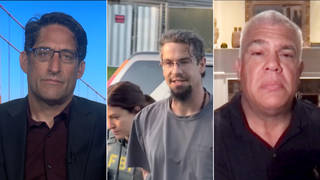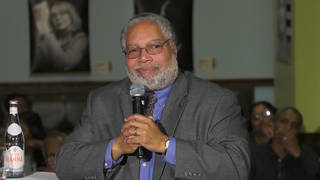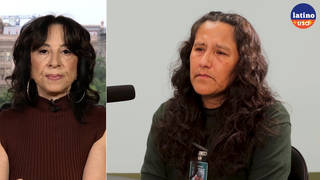
Guests
- Gail Johnsondefense attorney for Clarence Moses-EL.
- Susan Greeneeditor of The Colorado Independent. She is a longtime reporter and columnist, formerly with The Denver Post.
A Denver, Colorado, man has spent 28 years in prison based on a dream—and it wasn’t his. Now he could soon be free. In 1989, Clarence Moses-EL, who is African-American, was sentenced to 48 years in prison after a woman said she dreamed he was the man who raped and beat her in the dark. The victim said she was raped in her apartment after a night out drinking at a party. She was beaten so badly during the attack that she suffered broken facial bones and lost the use of one eye. Initially, the victim named three men she had been drinking with as her possible attackers—none of them was Clarence Moses-EL. But police never investigated any of those men, because, a day and a half later, the victim said she had a dream that Moses-EL was the one who raped her. Moses-EL has always maintained his innocence. But the police threw out a rape kit and any possible evidence, like bed sheets and her clothes. This summer, another man confessed to the attack, yet Moses-EL remained in prison. Now a judge has lifted his conviction, but Moses-EL still remains in jail. He could be freed as early as Tuesday, when a bond hearing has been set. The District Attorney’s Office has not yet said if they will attempt to retry him for the crime. We speak with Colorado Independent editor Susan Greene, who has long covered the story, and with Moses-EL’s attorney, Gail Johnson.
Transcript
JUAN GONZÁLEZ: We turn now to the case of a Denver, Colorado, man who has spent 28 years in prison based on a dream—and it wasn’t his own. That’s right. In 1989, Clarence Moses-EL, who is African-American, was sentenced to 48 years in prison after a woman said she dreamed he was the man who raped and beat her in the dark. The victim said she was raped in her apartment after a night out drinking at a party. She was beaten so badly during the attack that she suffered broken facial bones and lost the use of one eye. Initially, the victim named three men she had been drinking with as her possible attackers—none of them was Clarence Moses-EL. But police never investigated any of those men, because, a day and a half later, the victim said she had a dream that Moses-EL was the one who had raped her.
AMY GOODMAN: Since day one, Clarence Moses-EL has maintained his innocence. In 1995, he won a court order to analyze evidence that could have proved his innocence. He persuaded his fellow prisoners to chip in a thousand dollars to pay for DNA testing. Denver police packaged the evidence, which included the victim’s rape kit, her clothes and bed sheets in a box, and marked it, “DO NOT DESTROY.” But then, the police threw the box in a dumpster.
JUAN GONZÁLEZ: The story doesn’t end there. One of three people the victim initially listed as a possible attacker was a man named L.C. Jackson. In 2012, Jackson sent Clarence Moses-EL a letter in prison that read in part, quote, “Let’s start by bringing what was done in the dark into the light.” In court this past summer, Jackson confessed to the attack, admitting that he had what he claimed was consensual sex with the victim and beat her that night in her apartment. Jackson’s then live-in girlfriend corroborated his testimony, saying he left their house during the time of the attack, and blood evidence pointed to someone with Jackson’s blood type, not Moses-EL’s. Yet Clarence Moses-EL has remained in prison, and Denver District Attorney Mitchell Morrissey has fought for years to uphold his conviction.
AMY GOODMAN: During the 28 years Moses-EL has fought for his freedom, a number of his family members have passed away, including his mother, who died in 2013. He has 12 grandchildren whom he has never met, because he doesn’t want them to see him behind bars.
Well, on Monday, Clarence Moses-EL finally won a major victory, when a judge lifted his conviction. He could be freed as early as this next Tuesday, when a bond hearing has been set. The District Attorney’s Office has not yet said if they will attempt to retry him for the crime.
For more on this case, we’re joined by Susan Greene, editor of The Colorado Independent, who has reported on Clarence Moses-EL’s case for years. Gail Johnson is Moses-EL’s defense attorney. And we also will also hear from Lynn Kimbrough, spokesperson for the Denver District Attorney’s Office.
Let us start with Susan. How did you learn of this story? You have championed this case for years in your reporting.
SUSAN GREENE: I used to work at The Denver Post, Amy, and we worked for a year on a series called “Trashing the Truth,” which was about the loss and destruction of DNA evidence. It was a national series of stories about what happens when these tiny parcels of biological evidence go lost or missing. And Clarence’s case was the story we started the week-long series with, because it was so flagrant, with the—so much DNA evidence being right there, Clarence having raised the money in prison to test it. And the police, despite the fact that it was in a box marked “DO NOT DESTROY” and he had two court orders to have it tested, threw it in a dumpster. So, that’s how I got to know Clarence about nine or 10 years ago.
JUAN GONZÁLEZ: And was anyone ever held responsible or discovered who decided to throw out that kit, that evidence?
SUSAN GREENE: Nobody ultimately was held responsible. There was a slight investigation, and it was deemed that there was a lack of communication between the DA’s Office and the police department, that the DA’s Office didn’t notify the police department that there were two court orders to test the DNA. Now, how that explains how someone could physically take a box marked “DO NOT DESTROY” in magic marker and throw it in the dumpster, I don’t know.
AMY GOODMAN: Gail Johnson, you’re the defense attorney for Clarence Moses-EL. Can you explain how 28 years ago, in this trial, a woman who was clearly a victim of a rape and a brutal assault could say that the only—the only evidence they had was this dream that she had? And based on a dream—she had actually named people she thought might have been her attackers, and they weren’t Moses-EL. But based on this dream, he was convicted?
GAIL JOHNSON: That’s correct, Amy. And, you know, what decades of experience now in this country with exonerations and wrongful convictions research has shown is that eyewitness misidentifications are a major cause of wrongful convictions. And that’s what happened in this case.
AMY GOODMAN: How was this eyewitness? It’s a dream.
GAIL JOHNSON: It’s an eyewitness in the sense that she’s the only person who’s identified him, because she now claims, and claimed at trial, that he was her attacker. But there are lots of reasons to doubt the reliability of that. We’re not saying this was malicious on her part, but certainly she was heavily intoxicated, so much so that she had passed out before the attack and vomited. She had been drinking malt liquor that night with L.C. Jackson and others. She also had very poor eyesight. It was dark when she was attacked. And the attacker beat her about the face, which was quite traumatic.
JUAN GONZÁLEZ: And you mentioned L.C. Jackson. When he then sent this letter to your client in prison, what was—what was then the reaction in terms of the criminal justice system and the courts?
GAIL JOHNSON: Well, it’s an excellent question, Juan. Mr. Moses-EL filed a motion for a new trial based on newly discovered evidence—namely, that L.C. Jackson was now admitting his involvement in these events. The Denver District Attorney’s Office did not go out and talk to Mr. Jackson about those statements for 18 months after those admissions became public. So, the system was slow to respond. But ultimately, as Amy explained, we now have a major breakthrough in the case. Mr. Jackson has testified in court, under oath, before a Denver district judge, about his involvement. He has admitted, under oath, that he went to the victim’s home at the time of the attack, that he had sexual intercourse with her, that he physically assaulted her.
AMY GOODMAN: On Thursday, Democracy Now! spoke to Denver district attorney spokesperson Lynn Kimbrough. We asked her if the Denver DA is seeking a new trial for Clarence Moses-EL.
LYNN KIMBROUGH: The decision on whether or not to seek a new trial has not been made. The district attorney will review the court’s ruling in its entirety, from a legal perspective. And in addition to conducting a review of the decision, he’ll also be meeting with the victim. And both of those things will take place before he makes a decision.
AMY GOODMAN: So, can you tell us what has been the position of the Denver district attorney?
GAIL JOHNSON: Well, so far, the Denver District Attorney’s Office has been fighting Mr. Moses-EL’s attempts to vindicate his innocence at every turn, including fighting our access to some documents that—from Mr. Jackson’s sex assault case. And I think one of the important things for your listeners to understand today is that this Denver District Attorney’s Office prosecuted Mr. Jackson years later on what’s known on as a cold hit DNA case for the brutal sexual assault of a woman and her nine-year-old daughter in their home that occurred about a mile, mile and a half from the events underlying Mr. Moses-EL’s case. There are some striking similarities between the manner in which those assaults were committed and, again, the assault in the 1987 case for which Mr. Moses-EL has been incarcerated for 28 years. So when you put together Mr. Jackson’s history, criminal history, as well as his admissions, as well as—we presented evidence that—from his girlfriend at the time of the assault, who said he left the house right after—about 20 minutes after the victim—she lived two doors down—and that he was gone for an hour or two, and then he returned to her presence, and then, about 20 minutes later, they learned about the assaults that had happened. So, he was gone at the exact moment of the assaults.
JUAN GONZÁLEZ: And, Susan Greene, I’d like to ask you, since you’ve been following this story for so many years, one, what’s been the reaction of the other media in Denver, in Colorado, to this story? And why do think the district attorney has been so intransigent on this case?
SUSAN GREENE: The reaction by other media really has been to ignore this case for years. I wrote about it at The Denver Post; when I left The Denver Post, I continued writing about it. I’m now with The Colorado Independent. But when I left, The Denver Post and all other media have ignored this case. Nobody went to the hearing. Nobody’s done any investigative work on it at all. And I think that’s largely because there has been so much misinformation put out by the DA’s Office. This is a DA who, in this case, has simply made stuff up, ad hominem. And we have a media market here that just doesn’t have the kind of investigative journalism resources to dig in. And not only that, we have a media here that is cowed by the powers that be here so much that Mitch Morrissey will dish out facts about this—not facts about this case, misinformation about this case, and the media will buy it. And so, this is not just a problem in the DA system, it’s a problem systemwide. And it’s why journalism is so important.
AMY GOODMAN: Just let me ask you, back in 2012, three years ago, L.C. Jackson wrote this letter to Clarence Moses-EL in prison, and it read, quote, “I really don’t know what to say to you. But let’s start by bringing what was done in the dark into the light. I have a lot on my heart. I don’t know who['s] working on this. But have them come up and see me. It's time. I’ll be waiting.” That’s what Jackson wrote to Moses-EL. That was in 2012. What happened as a result of that letter, Susan Greene?
SUSAN GREENE: What happened is, Clarence, from prison, who really has been just kind of silently in prison, for the most part, for 28 years, tried to get a new hearing. And it took, I think, about three years for that process to move forward. You would think—and the DA was made aware of that letter fairly early on, so you would think, because a DA’s responsibility is to seek the truth and to fact find and to make sure, if there’s new evidence, it’s looked at. But that’s actually not the case. The DA ignored this new evidence. Not only did it ignore the new evidence, that office, but it kept maintaining, incorrectly, as Mitch Morrissey has done for at least 10 years now, that the victim never named L.C. Jackson in her outcry. And that’s incorrect. He has testified to that in the Legislature, he has said that in press releases, he’s said that in videos. And again, this goes back to the media. People buy it. What the documents show, the police reports show and the court records show is, in fact, the victim several times named L.C. Jackson in her outcry. She never named Clarence Moses-EL in her outcry.
What it also—what nobody else has really talked about is that the lead detective in the case in the Denver Police Department said before he died, he always had reservations about this case. And the reason he had reservations is because the victim, before she was attacked—and she was brutally attacked, Amy—had had a fight with Moses-EL’s wife and had said publicly, “I’m going to get back at you.” And so, this detective had concerns that it was a personal vendetta that made—that prompted the victim to have this so-called dream, that is, as Gail said, the only evidence on which Clarence was convicted.
AMY GOODMAN: Where is Clarence Moses-EL right now?
SUSAN GREENE: He is in a prison called Territorial in Colorado. He has lived for many, many years in the Bent County Correctional Facility, which is hours away from Denver. He was transferred yesterday, on his way to Denver, to bond out, but didn’t make it here because, I guess, he needed to transfer from prisons. It’s like a terrible, never-ending bus ride. So he’s in Territorial, and hopefully he’s on his way to Denver today, hopefully, if the DA doesn’t continue fighting it, to bond out.
AMY GOODMAN: Gail Johnson, do you think Clarence Moses-EL will be home for Christmas?
GAIL JOHNSON: I do, Amy. There’s been an incredible outpouring of support for Mr. Moses-EL and his situation and his plight. And our hope is that a reasonable bond will be set and he will be able to make that and be home for Christmas.
AMY GOODMAN: We thank you both for being with us, Gail Johnson, defense attorney for Clarence Moses-EL, and Susan Greene, editor of The Colorado Independent. We’ll link to your pieces on Clarence Moses-EL.
This is Democracy Now! When we come back, we’ll talk about Yemen. Stay with us.











Media Options